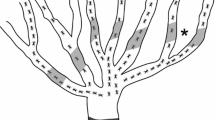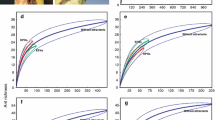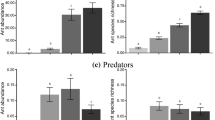Abstract
Ant–plant interactions have mainly been considered as a protection mutualism where ants increase plant performance through protection from herbivory. However, host plants may also benefit from nutrients deposited by ants. Nitrogen limits the plant growth in most terrestrial ecosystems and the nutrient exchange between ants and plants may be an important mechanism operating in ant–plant interactions. In this study, we quantified the exchange of macronutrients (carbon and nitrogen) between ants and plants, using the Asian weaver ant Oecophylla smaragdina as a model species in a mango agroecosystem. A method was developed with which the amount of nitrogen retrieved to their host trees could be predicted by the trail density of O. smaragdina. Ant nutrient consumption was calculated based on data on O. smaragdina abundance and per capita consumption rates obtained in laboratory colonies. On a yearly basis, the influx of nitrogen to the host tree, originating from captured prey, averaged 14.4 (range 8.0–46.4) kg N ha−1 y−1. The loss of carbon from the host tree due to ant consumption of exudates from nectaries and tended homopterans averaged 278.1 (range 149.3–939.9) kg C ha−1 y−1. O. smaragdina may provide their host plant with a significant source of nitrogen albeit a substantial amount of carbon is consumed from the host plant. This study reveals that the flow of nutrients between ants and plants may play a critical and underestimated role in ant–plant mutualisms.




Similar content being viewed by others
References
Blüthgen N, Fiedler K. 2002. Interactions between weaver ants Oecophylla smaragdina, homopterans, trees and lianas in an australian rain forest canopy. J Anim Ecol 71(5):793–801.
Blüthgen N, Gottsberger G, Fiedler K. 2004. Sugar and amino acid composition of ant-attended nectar and honeydew sources from an australian rainforest. Austral Ecol 29(4):418–29.
Blüthgen N, Verhaagh M, Goitia W, Jaffe K, Morawetz W, Barthlott W. 2000. How plants shape the ant community in the amazonian rainforest canopy: the key role of extrafloral nectaries and homopteran honeydew. Oecologia 125(2):229–40.
Blüthgen N, Stork NE. 2007. Ant mosaics in a tropical rainforest in australia and elsewhere: a critical review. Austral Ecol 32(1):93–104.
Chamberlain SA, Holland JN. 2009. Quantitative synthesis of context dependency in ant-plant protection mutualisms. Ecology 90(9):2384–92.
Chen Y, Robinson EJH. 2013. A comparison of mark-release-recapture methods for estimating colony size in the wood ant formica lugubris. Insectes Soc 60(3):351–9.
Clay NA, Lucas J, Kaspari M, Kay AD. 2013. Manna from heaven: refuse from an arboreal ant links aboveground and belowground processes in a lowland tropical forest. Ecosphere 4(11):1–15.
Correa A, Cruz C, Ferrol N. 2015. Nitrogen and carbon/nitrogen dynamics in arbuscular mycorrhiza: the great unknown. Mycorrhiza 25(7):499–515.
Correa A, Gurevitch J, Martins-Loucao MA, Cruz C. 2012. C allocation to the fungus is not a cost to the plant in ectomycorrhizae. Oikos 121(3):449–63.
Davidson D. 1997. The role of resource imbalances in the evolutionary ecology of tropical arboreal ants. Biol J Linn Soc 61(2):153–81.
Davidson D, Cook S, Snelling R, Chua T. 2003. Explaining the abundance of ants in lowland tropical rainforest canopies. Science 300(5621):969–72.
Domisch T, Finer L, Neuvonen S, Niemela P, Risch AC, Kilpelainen J, Ohashi M, Jurgensen MF. 2009. Foraging activity and dietary spectrum of wood ants (formica rufa group) and their role in nutrient fluxes in boreal forests. Ecol Entomol 34(3):369–77.
Finer L, Jurgensen MF, Domisch T, Kilpelainen J, Neuvonen S, Punttila P, Risch AC, Ohashi M, Niemela P. 2013. The role of wood ants (formica rufa group) in carbon and nutrient dynamics of a boreal norway spruce forest ecosystem. Ecosystems 16(2):196–208.
Floren A, Biun A, Linsenmair K. 2002. Arboreal ants as key predators in tropical lowland rainforest trees. Oecologia 131(1):137–44.
Folgarait P. 1998. Ant biodiversity and its relationship to ecosystem functioning: a review. Biodivers Conserv 7(9):1221–44.
Gegenbauer C, Mayer VE, Zotz G, Richter A. 2012. Uptake of ant-derived nitrogen in the myrmecophytic orchid caularthron bilamellatum. Ann Bot 110(4):757–65.
Heil M, McKey D. 2003. Protective ant-plant interactions as model systems in ecological and evolutionary research. Annu Rev Ecol Evol Syst 34:425–53.
Heil M, Orona-Tamayo D, Eilmus S, Kautz S, Gonzalez-Teuber M. 2010. Chemical communication and coevolution in an ant-plant mutualism. Chemoecology 20(2):63–74.
Hölldobler B, Wilson EO. 1990. The ants. Cambridge: Belknap Press of Harvard University Press.
Hölldobler B. 1983. Territorial behavior in the green tree ant (Oecophylla-smaragdina). Biotropica 15(4):241–50.
Horstman K. 1974. Investigations on food-consumption of red wood ants (formica-polyctena foerster) in an oak forest.3. Annual turnover. Oecologia 15(2):187–204.
Huett DO, Dirou JF. 2000. An evaluation of the rationale for fertiliser management of tropical fruit crops. Aust J Exp Agric 40:1137–43.
Lokkers C. 1990. Colony dynamics of the green tree ant (Oecophylla smaragdina fab.) in a seasonal tropical climate. PhD thesis, James Cook University. http://eprints.jcu.edu.au/24114/.
Lynegaard GK, Offenberg J, Fast TS, Axelsen JA, Mwatawala MW, Rwegasira GM. 2014. Using insect traps to increase weaver ant (Oecophylla longinoda) prey capture. J Appl Entomol 138(7):539–46.
Offenberg J. 2015. Ants as tools in sustainable agriculture: the case of weaver ants and beyond. J Appl Ecol 52:1197–205.
Offenberg J. 2007. The distribution of weaver ant pheromones on host trees. Insectes Soc 54(3):248–50.
Offenberg J, Nielsen M, MacIntosh D, Havanon S, Aksornkoae S. 2004. Evidence that insect herbivores are deterred by ant pheromones. Proc R Soc B Biol Sci 271:433–5.
Offenberg J, Cuc Nguyen Thi Thu, Wiwatwitaya D. 2013. The effectiveness of weaver ant (Oecophylla smaragdina) biocontrol in southeast asian citrus and mango. Asian Myrmecol 5:139–49.
Oliveira P. 1997. The ecological function of extrafloral nectaries: herbivore deterrence by visiting ants and reproductive output in Caryocar brasiliense (caryocaraceae). Funct Ecol 11(3):323–30.
Palmer TM, Brody AK. 2013. Enough is enough: the effects of symbiotic ant abundance on herbivory, growth, and reproduction in an african acacia. Ecology 94(3):683–91.
Peng R, Christian K. 2005. Integrated pest management for mango orchards using green ants as a major component. A manual for conventional and organic mango growers in Australia. School of Science and Primary Industries, Charles Darwin University, Darwin.
Peng R, Christian K, Gibb K. 2012. The best time of day to monitor and manipulate weaver ant colonies in biological control. J Appl Entomol 136(1–2):155–60.
Pinkalski C, Damgaard C, Jensen KV, Peng R, Offenberg J. 2015a. Quantification of ant manure deposition in a tropical agroecosystem: implications for host plant nitrogen acquisition. Ecosystems 18:1373–82.
Pinkalski C, Damgaard C, Jensen KV, Gislum R, Peng R, Offenberg J. 2015b. Non-destructive biomass estimation of Oecophylla smaragdina colonies: a model species for the ecological impact of ants. Insect Conserv. Divers. 8(5):464–73.
Read D. 1991. Mycorrhizas in ecosystems. Experientia 47(4):376–91.
Rosumek FB, Silveira FAO, Neves FdS, Barbosa NPdU, Diniz L, Oki Y, Pezzini F, Fernandes GW, Cornelissen T. 2009. Ants on plants: a meta-analysis of the role of ants as plant biotic defenses. Oecologia 160(3):537–49.
Rudgers JA, Hodgen JG, White JW. 2003. Behavioral mechanisms underlie an ant-plant mutualism. Oecologia 135(1):51–9.
Shukla RK, Singh H, Rastogi N, Agarwal VM. 2013. Impact of abundant pheidole ant species on soil nutrients in relation to the food biology of the species. Appl Soil Ecol 71:15–23.
Solano P, Dejean A. 2004. Ant-fed plants: comparison between three geophytic myrmecophytes. Biol J Linn Soc 83(4):433–9.
Styrsky JD, Eubanks MD. 2007. Ecological consequences of interactions between ants and honeydew-producing insects. Proc R Soc B Biol Sci 274(1607):151–64.
Suzuki S, Kitayama K, Aiba S, Takyu M, Kikuzawa K. 2013. Annual leaf loss caused by folivorous insects in tropical rain forests on mt. kinabalu, borneo. J Forest Res 18(4):353–60.
Tobin J. 1994. Ant as primary consumers: diet and abundance in the formicidae. In: Hunt JH, Nepala CA, Eds. Nourishment and evolution in insect societies. Westview: Boulder.
Trager MD, Bhotika S, Hostetler JA, Andrade GV, Rodriguez-Cabal MA, McKeon CS, Osenberg CW, Bolker BM. 2010. Benefits for plants in ant-plant protective mutualisms: a meta-analysis. PLoS ONE 5(12):e14308.
Treseder K, Davidson D, Ehleringer J. 1995. Absorption of ant-provided carbon-dioxide and nitrogen by a tropical epiphyte. Nature 375(6527):137–9.
Van Mele P. 2008. A historical review of research on the weaver ant oecophylla in biological control. Agric Entomol 10(1):13–22.
Vidkjær NH, Wollenweber B, Jensen KMV, Ambus PL, Offenberg J, Fomsgaard IS. 2016. Urea in weaver ant feces: quantification and investigation of the uptake and translocation of urea in Coffea arabica. J Plant Growth Regul. doi:10.1007/s00344-016-9586-1.
Vidkjær NH, Wollenweber B, Gislum R, Jensen KV, Fomsgaard IS. 2015. Are ant feces nutrients for plants? A metabolomics approach to elucidate the nutritional effects on plants hosting weaver ants. Metabolomics 11(4):1013–28.
Wackers F, Bonifay C. 2004. How to be sweet? Extrafloral nectar allocation by Gossypium hirsutum fits optimal defense theory predictions. Ecology 85(6):1512–18.
Wackers F, Zuber D, Wunderlin R, Keller F. 2001. The effect of herbivory on temporal and spatial dynamics of foliar nectar production in cotton and castor. Ann Bot 87(3):365–70.
Wagner D. 1997. The influence of ant nests on acacia seed production, herbivory and soil nutrients. J Ecol 85(1):83–93.
Wagner D, Nicklen EF. 2010. Ant nest location, soil nutrients and nutrient uptake by ant-associated plants: does extrafloral nectar attract ant nests and thereby enhance plant nutrition? J Ecol 98(3):614–24.
Way M, Khoo K. 1992. Role of ants in pest-management. Annu Rev Entomol 37:479–503.
Acknowledgements
This study was funded by the Danish Council for Independent Research (11-106824)
Conflict of interest
All authors declare that they have no conflict of interest
Author information
Authors and Affiliations
Corresponding author
Additional information
Author contributions
CP, KMVJ, RP, and JO conceived the work. CP carried out the field work with assistance from RP. CP and CD analysed the data and constructed the model. CP wrote the paper under supervision from KMVJ and JO.
Electronic supplementary material
Below is the link to the electronic supplementary material.
Rights and permissions
About this article
Cite this article
Pinkalski, C., Damgaard, C., Jensen, KM.V. et al. Macronutrient Exchange Between the Asian Weaver Ant Oecophylla smaragdina and Their Host Plant. Ecosystems 19, 1418–1428 (2016). https://doi.org/10.1007/s10021-016-0013-z
Received:
Accepted:
Published:
Issue Date:
DOI: https://doi.org/10.1007/s10021-016-0013-z




